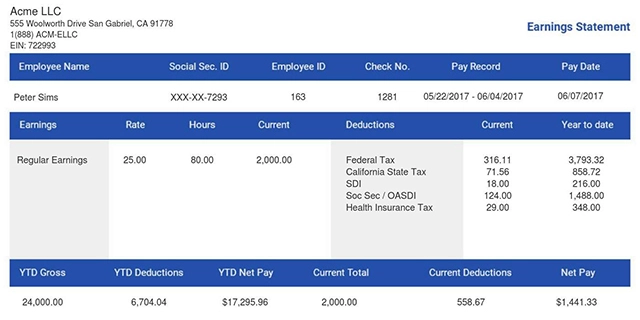What Is a Floating Holiday? And How It Works
A floating holiday is a paid day off that employees can schedule at their discretion. It is a key part of work-life balance, filling the gap between fixed company holidays and personal time off. Most employers use it as a means to support religious or cultural holidays.
Basically, the floating holiday is “a paid day that floats,” and is subject to the company's floating holiday policy. This article explains what a floating holiday is, how companies can structure them efficiently. You will also learn how to handle requests, carryovers, unused days, and track floating holiday pay with company pay stubs.
- What Is a Floating Holiday?
- Difference Between a Paid Leave and a Floating Holiday
- How Do Floating Holidays Work?
- Floating Holidays vs Paid Time Off PTO vs Paid Holidays
- Why Do Employers Offer Floating Holidays?
- How Many Floating Holidays Do Companies Give?
- How To Draft Floating Holiday Policies
- How To Calculate Floating Holiday Pay
- What To Do With Unused Floating Holidays
- Floating Holiday Policy Tips for Employees and Supervisors
- To Sum It Up
What Is a Floating Holiday?
A floating holiday is a paid holiday that an employee can fix on their own schedule. Unlike the fixed or regular holidays, paid holidays are not tied to the company calendar. An employee can schedule the holiday at their discretion.
Employers usually grant two floating holidays per year as part of the company’s benefits package. It's a way to improve employee satisfaction and encourage better work-life balance. Employees use floating holidays for religious holidays, cultural celebrations, and other personal events.
Difference Between a Paid Leave and a Floating Holiday
There are key essential features that differentiate a floating holiday from paid leave:
-
Has expiration dates
-
Scheduled based on the employee’s discretion
-
Guided by the company’s floating holiday policy
-
Subject to approval by the employee’s supervisor
-
Usually included as part of the benefits package
-
Limited number of floating holidays in a calendar year
A floating holiday is different from a public holiday or Labor Day holiday. A floating holiday allows employees to feel valued in a workplace. It translates to increased engagement and productivity.
How Do Floating Holidays Work?
The floating holiday policy in an organization determines how they work. This varies between companies. These types of paid holidays are not subject to federal laws.
However, in some states in the US, labor laws, union laws, or state laws may apply. It's up to the employer to decide whether offering floating holidays should be part of their benefits package. In most companies and organizations, employers use this simplified process for floating holidays:
-
Allocation: Employers often provide floating holidays as an annual lump sum. For example, companies may offer floating holidays as one or two paid days per calendar year.
-
Request and approval: Employees request floating holidays through the usual time-off system. Approval depends on staffing and business needs. Supervisors often handle approvals to avoid scheduling conflicts. They do this to ensure it does not disrupt company operations.
-
Use-it-or-lose-it vs carryover: In this case, you use floating holidays within the calendar year. Others offer employees a carryover option, but for a limited time.
-
Blackout dates: Employers sometimes set blackout periods. These periods are when floating holidays may not be approved. This is to ensure the efficient functioning of key operations is not affected by employees' personal time off.
-
Tracking: Employers may track floating holiday pay in hours or on specific dates inside payroll check stub software or HR systems.
This creates a reliable and flexible system. It keeps all key stakeholders informed while also protecting operations.
Floating Holidays vs Paid Time Off PTO vs Paid Holidays

A common error is to mistake floating holidays, paid time off, and paid holidays to mean the same thing. While they do interlap on certain levels, they are also very different.
Companies use each of them for different purposes:
-
Floating holidays are usually a small number of extra paid days that “float” to the date the employee chooses.
-
Paid time off PTO typically combines vacation and sick time into an accrual bank.
-
Paid holidays like Presidents' Day are fixed dates.
Here's a closer comparison of each one, where they overlap and how they work.
| Feature | Floating holidays | Paid time off (PTO) | Paid holidays |
| No of days | 1 to 3 days | Accrued | Fixed dates |
| Use | Employee’s choice | Paid leave | Employer-set |
| Accrual | Not accrued | Accrual-based | Fixed |
| Carryover | Employer policy | Policy or state laws | N/A |
| Payroll treatment | Paid day off | Paid per policy | Paid day off |
This shows how each one works and where most companies stand. It can help HR teams decide whether adding floating holidays to paid time off is a good idea or not.
Why Do Employers Offer Floating Holidays?
Floating holidays provide employees with an opportunity for a better work-life balance. Employers also adopt it as a means to embrace diverse cultures. Here are some more reasons why employers offer floating holidays:
-
To improve work-life balance: Employees gain flexibility and more control over their time. They can use this chance to mark significant events, such as religious practices and cultural events.
-
Employee satisfaction and engagement: Offering floating holidays to employees encourages employee engagement. Floating holidays are perfect for employee birthdays or after hitting a personal milestone. It can also be a means of employee appreciation.
-
Competitive job market: One of the reasons for offering floating holidays is the potential benefits it offers. It serves as a way for companies to attract top talent and prospective employees.
-
Business continuity: A floating holiday helps employers reduce administrative burden. It can also manage peak-day absences. By letting staff choose alternate days, employers can plan and adjust for different circumstances.
Floating holidays allow employees to manage personal events outside their vacation or sick time. Employers weigh several benefits of a floating holiday against their company’s needs in a floating holiday policy
How Many Floating Holidays Do Companies Give?
The number of floating holidays varies based on the company’s floating holiday policies. In most organizations, a typical floating holiday policy would engage one or more of these patterns:
-
Many companies give one to two floating holidays per year.
-
Some larger organizations offer two floating holidays plus a rich holiday schedule.
-
Some employers in diverse regions double-fix the floating holidays. This is structured to cover religious events and cultural observances.
In some cases, employers use employee surveys to understand how employees feel about floating holidays. They then use this information to determine their company’s floating holiday policy. Hybrid solutions, such as fixed “personal days” holidays and a floating day, also work well.
Claiming a floating holiday and need it on record? Enter the holiday date, hours, and pay rate using the 123 Paystub method, preview, and download a verified proof of payment.
How To Draft Floating Holiday Policies
Clear floating holiday policies help to prevent confusion and inconsistencies in the workplace. Here's a simple checklist you can use when drafting floating holiday policies:
-
Definition: Clearly define your floating holiday with no ambiguity. Is it a paid holiday, paid leave, or paid time off?
-
Eligibility: Define when employees can take floating holidays. Specify the flexible time and which employees qualify (full-time, part-time, tenure).
-
How many floating holidays: “Employees receive two floating holidays per calendar year.”
-
Request floating holidays: Specify the notice and approval workflow for floating holiday requests. Also state who approves the floating holiday request.
-
Use period and expiration dates: Include the flexible time that works with the company’s calendar year. Also, include what happens to unused floating holidays and their expiration dates
-
Pay rules: Specify how the payment applies to floating holidays vs other existing vacation time. Clearly distinguish the payment terms from those of paid time off, paid holidays, and paid leave.
Ensure all of these details are included in the employee handbook.
How To Calculate Floating Holiday Pay
A floating holiday is paid at the employee’s regular rate for the scheduled hours they would have worked that day. It's similar to paid leave or paid sick days, but for different purposes in the workplace.
-
If an employee normally works eight hours per day, the floating holiday pay equals eight hours at their standard rate.
-
For hourly staff, log floating holiday hours like a regular paid day.
-
For salaried staff, pay remains unchanged.
The pay for a floating holiday based on overtime pay differs from regular time. Employers may track floating holiday hours in hours or days.
Overtime pay rarely applies to floating holidays. Unless the employee works additional hours that trigger overtime under the Fair Labor Standards Act (FLSA).
What To Do With Unused Floating Holidays
Unused floating holiday policies vary widely across different organizations. Here are some of the ways to deal with this:
-
Use-it-or-lose-it: Unused days expire at the calendar year's end.
-
Limited carryover: Allow one day to carry into the next year.
-
Payout at termination: Floating holidays may be paid out at separation. State law and the company's floating holiday policy control this.
Sometimes, employees' floating holidays may expire before it is used. What really happens to it should be determined based on what favors both the employee and the employer.
Floating Holiday Policy Tips for Employees and Supervisors
Avoid issues with transparent rules, a fair approval process, and HR tools that show real-time staffing coverage. Here are some helpful tips for both employers and employees:
For employees:
-
Check the employee handbook or company portal for the company's policy.
-
Submit a request through the standard time-off system and explain the reason briefly if required.
-
Avoid blackout dates and plan around busy periods.
For supervisors:
-
Balance team coverage and fairness.
-
Offer alternatives if multiple floating holiday requests conflict.
-
Communicate approvals in writing and update payroll to reflect the paid day.
-
Add policy to the employee handbook.
-
Update payroll categories for floating holiday pay.
-
Train managers on fair approvals.
-
Communicate the new benefit to prospective and current employees.
-
Train employees on how to take floating holidays.
-
Clearly state why a floating holiday may or may not be approved
To Sum It Up
A clear floating holiday policy is a low-cost way to promote inclusion and better work-life balance. It helps employees observe religious or cultural holidays, such as Christmas Eve. Adopting such a benefit can be a way to appreciate personal milestones outside of vacation or sick days. If you manage payroll or HR, ensure you avoid approval conflicts and clarify any unused floating holidays.
To reconcile floating holiday hours with payroll, you can use a check stub creator to compute year-to-date totals and all paid days. That helps you verify that floating holiday pay appears correctly on records and on employment or loan applications.















